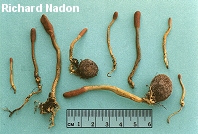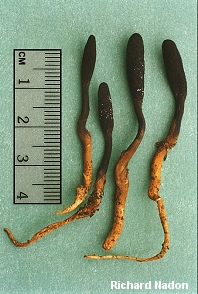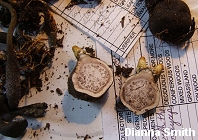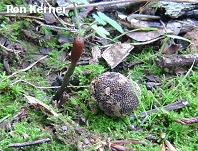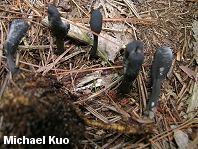| Major Groups > Mycotrophs > Cordyceps ophioglossoides |
| Major Groups > Clubs & Corals > Cordyceps ophioglossoides |

|
Cordyceps ophioglossoides [ Ascomycetes > Hypocreales > Clavicipitaceae > Cordyceps . . . ] by Michael Kuo Species of Cordyceps are my mushroom hunting nemeses. As far as I am concerned, they are about as cool as mushrooms can get; some of them parasitize underground puffballs, while the rest attack insects. But the challenge for a mushroom hunter is to recognize Cordyceps in the woods and manage to dig up, collect and/or photograph the parasitized puffball or bug. My record meeting this challenge is abysmal. The bottom photo to the right demonstrates my highest achievement with Cordyceps ophioglossoides, one of the puffball parasites. Usually, I pluck the little guys willy-nilly, thinking they are something like Geoglossum nigritum, and don't realize my mistake until much later, when I am studying a dried collection. Only once have I recognized Cordyceps in the woods; I took half a dozen photos and what you see is the best of the lot. Nice going, Michael. (The pinnacle of my Cordyceps failures can be seen on the page for the bug parasite Cordyceps militaris.) The salient features of Cordyceps ophioglossoides (print this up and take it to the woods with you if you want to avoid my mistakes) are: the tough, club-shaped fruiting bodies that lack a clearly defined cap; the reddish brown to black top area and the yellow to brownish or black lower area; the presence of yellow cords connecting the parasite and the puffball; and, of course, the presence underground of the parasitized puffball (which belongs to the genus Elaphomyces). Description: Ecology: Parasitic on underground puffballs (sometimes called "false truffles") in the genus Elaphomyces; late summer and fall; widely distributed in eastern North America. Fruiting Body: 2-8 cm long; up to 1 cm wide; club-shaped, with the top wider than the base; without a clearly defined "cap," but the upper portion reddish brown and smooth when young, becoming blackish and roughened or pimply (use a hand lens) with maturity; lower portion smooth throughout development, yellow to brownish or blackish, rooting; base attached to yellow cords that lead to the Elaphomyces fruiting body; flesh whitish and tough. Microscopic Features: Spores segmented and threadlike; breaking into elliptical segments 2-5 x 1.5-2 µ. REFERENCES: (Ehrhart, 1784) Link, 1833. (Mains, 1957; Smith, Smith & Weber, 1981; Breitenbach & Kränzlin, 1984; Phillips, 1991/2005; Lincoff, 1992; Horn, Kay & Abel, 1993; Barron, 1999; Roody, 2003; McNeil, 2006.) Herb. Kuo 09150704. This site contains no information about the edibility or toxicity of mushrooms. |
© MushroomExpert.Com |
|
Cite this page as: Kuo, M. (2006, October). Cordyceps ophioglossoides. Retrieved from the MushroomExpert.Com Web site: http://www.mushroomexpert.com/cordyceps_ophioglossoides.html |
